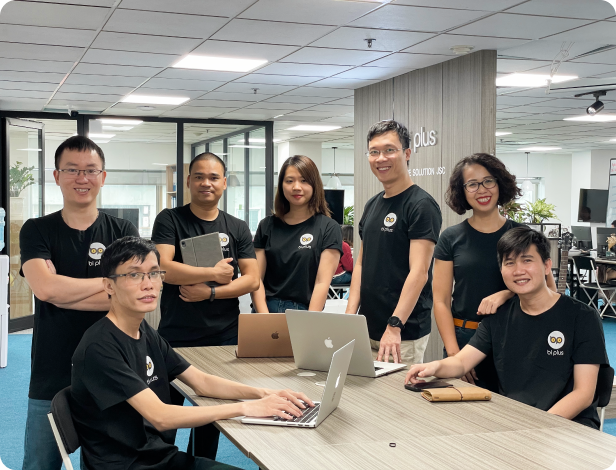We provide agile software
Outsourcing Services
Our services
Propose investment plans and implementation roadmap to build the system according to your business needs.
Distribute licenses of Atlassian software such as Jira Software, Confluence, Bitbucket, Trello and supplementary extensions.
Software Development
IT Services
Training & Consultancy
Atlassian Products
Who we are
Founded 2018, we have been providing software outsourcing and IT services to various clients in telecommunication, fintech, banking sector for SMEs and start-ups. BiPlus is also a Solution Partner of Atlassian in Vietnam.
Software Consultants
120+
Projects Delivered
10+
Solutions & Products
150+
120+
10+





Boost your business with our high-quality and cost-effective software solutions
Contact us

Why to choose us?
With extensive experience in managing large projects, organizing processes, and implementing software development tools, BiPlus can analyze and understand all customer needs and problems, consult on the best solution, and be a companion from the time a need arises until the product is handed over.
Software Development
IT Services
Training & Consulting
Atlassian Products

Why to choose us
Understanding & Companion Partner
With extensive experience in managing large projects, organizing processes, and implementing software development tools, BiPlus can analyze and understand all customer needs and problems, consult on the best solution, and be a companion from the time a need arises until the product is handed over.
Flexible & Effective Solutions
BiPlus provides customers better products and faster time to market by our experience in consulting, organizing, and operating software development using Agile methodology; capturing the system and understanding the issues of customers to propose effective solutions and technologies in the shortest time.
Full Services
We not only provide software development services to the requirements from customers but also advise and help our customers develop comprehensive solutions, including system analysis, architecture consulting, building solutions, consulting investment plans and product roadmap, developing, upgrading, migrating and operational training.
Our strength
With over 20 years of experience in various industries, we’ve accumulated proven expertise in providing sale & market sector. We know how to align technology with your business objectives. This allows us to build and implement powerful and complex ERP systems, as well as its separate modules.
- Sales Management
- Revenue Management
- Notification Management Gateway
- Commission Management
- Stock Management
We help businesses create and manage customer experiences through personalized interactions via various communication channels. Such interactions are enabled by personalized customer journeys that can be managed, analyzed, and optimized via a platform.
- Customer Experience
- Management
- Event Management
- MobileID
- Streaming Services
Thanks to our long-term cooperation with many #1 telecom companies in Asia and America, we know the main cornerstones of Telecom and how to manage them. Implementing our IT services for the telecom industry, you can be sure you get stable and secure solutions for your business and clients.
- Sales Management
- Customer Management
- Self-care
- Billing & Payment
System:
- eWallet Core
- PayGate
- eWallet (Mobile/Web/USSD)
Customer relationship management (CRM) software allows businesses to efficiently manage their relationships with other companies and customers. We develop custom CRM software for a broad range of industries, especially for companies which operate industries such as: telecom services, financial services, customer service,…
- Sales Management
- Customer Management
- Self-care
- Billing & Payment
- Service Problem Management
- Human Resources Management

Our clients

Free consultancy for an end-to-end software development service

Free consultancy for an end-to-end software development service
Our team
Our team includes of engineers and professionals that are experienced, knowledgeable and have extensive expertise to ensure the best project results for customers in different industries.

Bùi Phương Thảo
COO

Võ Minh Trí
CMSO

Phạm Thị Huyền
Operation Executive

Lâm Mạnh Thắng
Technical Leader

Nguyễn Lương Thái Đức
Technical Leader

Nguyễn Thị Thanh Xuân
QC Team Leader

Ngô Văn Huân
Technical Leader
What business leaders say about BiPlus
“What makes BiPlus different is the extensive experience of working with large telecommunications systems. BiPlus team clearly communicates progress and good coordination in projects, all information is sent via email and exchange meeting. BiPlus is the ability to support urgent work and the initiative in building solutions to software requirements“

“As a result of their satisfying deliverables, BiPlus remains a valuable partner that supports efficient deployments. Their capable project management enables streamlined collaboration. They show that they deeply understand large systems. They have a really confident project manager who came through with a very professional and cleanly structured process”

“BiPlus responded to our feedback well and improved them throughout the project. We was impressed with their clear communication. We received a detailed report and the done increment every 2 weeks.”

Technologies







